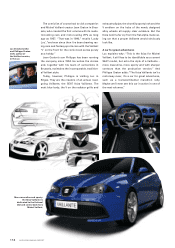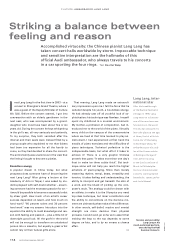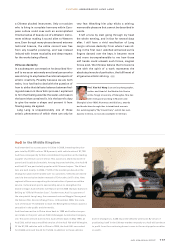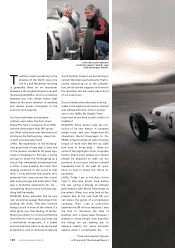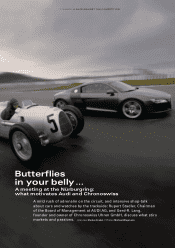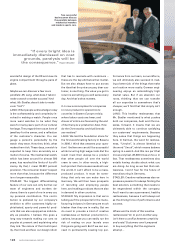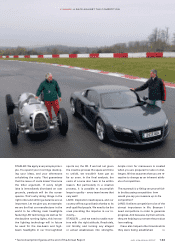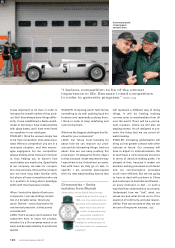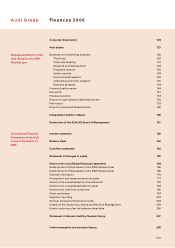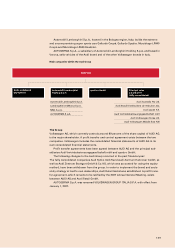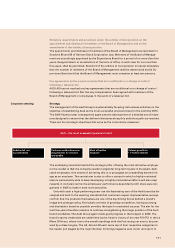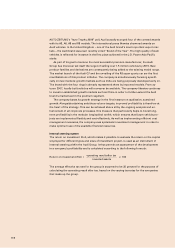Audi 2006 Annual Report Download - page 124
Download and view the complete annual report
Please find page 124 of the 2006 Audi annual report below. You can navigate through the pages in the report by either clicking on the pages listed below, or by using the keyword search tool below to find specific information within the annual report.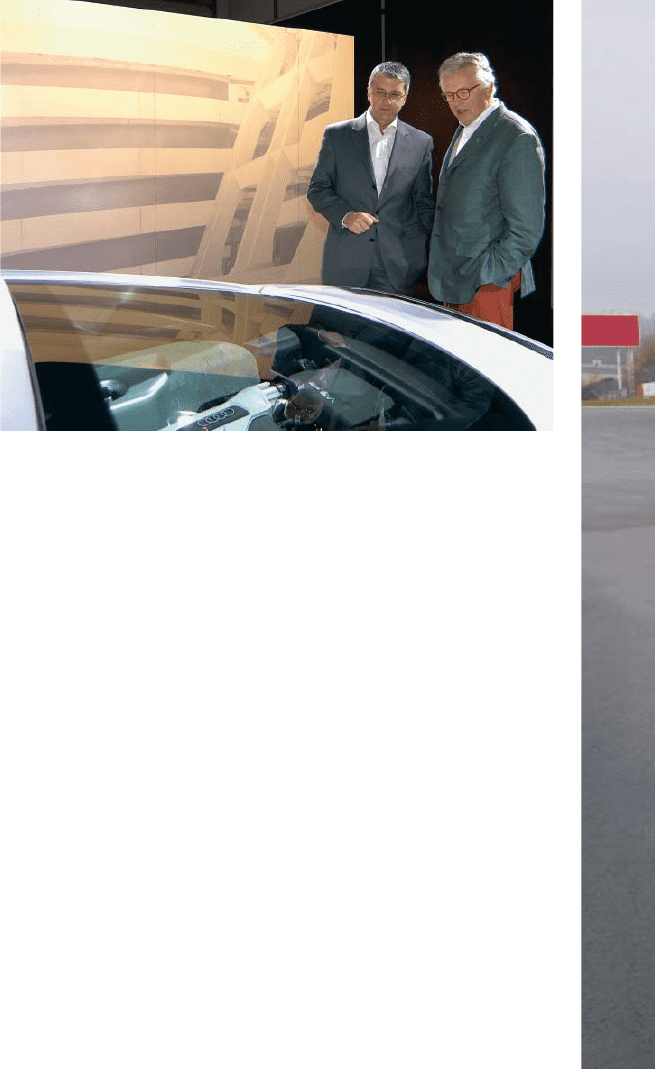
“If every bright idea is
immediately dismissed on cost
grounds, paralysis will be
the consequence.” Rupert Stadler
Two successful
businessmen discuss
the parallels between
mechanical watches
and modern sports cars.
122 AUDI 2006 ANNUAL REPORT
wonderful design of the R8 and view its
engine compartment through a pane of
glass.
Maybe we can discover a few more
parallels: Mr. Lang, what does it take to
make a watch a market success? And
what, Mr. Stadler, does it take to make
a car “tick”?
LANG: What people acknowledge today
is the craftsmanship and complexity in-
volved in making a watch. People once
more want watches to be what they
were for many years: part of our cultural
heritage. They regard them as an item of
jewellery for the owner, and a reflection
of the customer’s character. You can
gauge a person’s personality by the
watch they wear. How they think, what
makes them tick. These days, a watch is
expected to keep time accurately as a
matter of course. The mechanical watch,
which has been around for almost 500
years, has reached the limits of its effi-
ciency. By that, I mean 99.997 percent
precision. The consumer doesn’t expect
more than that, because the difference
is no longer measurable.
STADLER: The biggest differentiating
feature of our cars can only be that our
team of engineers and workers de-
clares: there is a part of me in every car,
my personal contribution. This contri-
bution is prefaced by our company’s
ambition to offer customers highly so-
phisticated, sporty and powerful prod-
ucts that are also equipped as individu-
ally as possible. I believe this goes a
long way towards making our cars so
popular at present and explaining why
they tick. The nature of their build qual-
ity, their look and feel, our design idiom
that has to resonate with customers –
these are the key attributes that matter.
But we also always have to put across
the idea that the price you pay, dear cus-
tomer, is one thing. The value you get in
return is something you will sense every
day. And that’s what matters.
It is now commonplace for companies
to move production operations to
countries in Eastern Europe or Asia,
where labour costs are lower, and
droves of critics are forecasting the end
of Germany as a production base. How
do the Chronoswiss and Audi brands
see matters?
LANG: We laid the foundation stone for
the first watchmaking factory in Bavaria
in 2006. I think that answers your ques-
tion! I believe we can still be successful
while incurring high wage costs. But the
result must then always be a product
that other people all over the world
crave to own. In other words, a high-
tech product that arouses needs all over
the world. It can’t afford to be a mass-
produced product. It must be some-
thing that only we can make here in
Germany. We will then have prospects
of recruiting and employing people
here, and making products that are also
in demand in other countries.
STADLER: My impression is that we’re
talking as if the prospects for the manu-
facturing industry in Germany are much
bleaker than they are in reality. But we
do need to provoke a kind of creative
restlessness at German production lo-
cations, because you can easily run the
risk of resting on your laurels once
things are going well. But if we can suc-
ceed in permanently coaxing top per-
formance from our team, our workforce,
we will ultimately also succeed in mak-
ing a better job of the things that make
our location more costly. German engi-
neering enjoys an astonishingly high
market value. But if we abandon our
roots, thinking that we can transfer
all our expertise to somewhere that’s
cheaper, we’ll find that that simply isn’t
enough.
LANG: This healthy restlessness that
Mr. Stadler mentioned is what pushes
both our companies, Audi and Chrono-
swiss, forward. It means that we are
ultimately able to continue satisfying
our customers’ requirements. Because
they sense that things are happening
here. In German, the word for restless-
ness, “Unruhe”, is almost identical to
the word “Unruh”, which means balance
spring in a watch. And this is a part that
moves very fast. 28,600 times an hour, in
fact. That restlessness sometimes also
entails having doubts about what you
are doing. As long as we feel that rest-
lessness, I won’t fear for the future of
manufacturing in Germany.
STADLER: Creative restlessness also ex-
presses a passion for always finding the
best solution, something that needs to
be engendered within the company.
And I want to see a permanent, healthy
restlessness, because it will always act
as the driving force of performance and
success.
Where are the limits of this creative
restlessness? Or, to put it another way,
isn’t there a conflict between creativity
and costs? Customers aren’t prepared
to buy everything that the engineers
develop …


